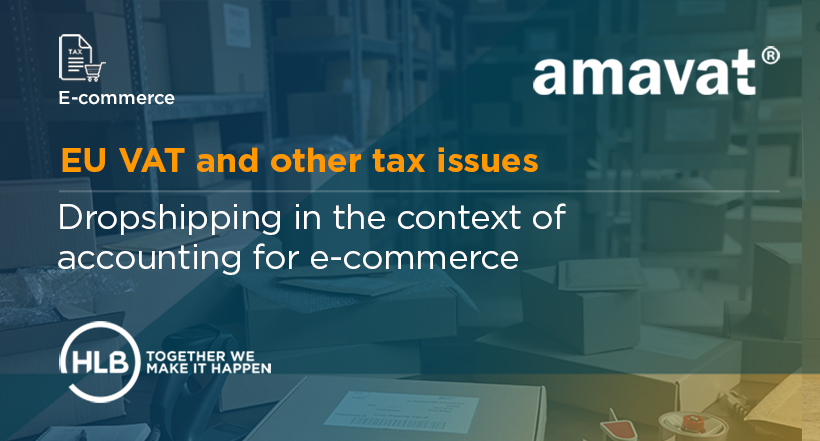Dropshipping in the context of accounting for e-commerce
Dropshipping is an increasingly popular and highly appreciated business model in the e-commerce industry. What exactly is it, and what are the accounting implications for e-commerce? How should VAT be accounted for in dropshipping? What are the advantages of dropshipping, and is it worth considering? Finally, what should be kept in mind when implementing dropshipping in the e-commerce industry? We provide answers!
Dropshipping in e-commerce – what is it and who uses it?
Dropshipping is a relatively popular and ostensibly simple logistical model, despite its challenging name. It is most commonly employed in the e-commerce sector, encompassing the operations of online stores or internet platforms engaged in electronic commerce. In practice, it involves outsourcing product shipment and logistics to a supplier, often a wholesaler.
The e-commerce entity, such as an online store, does not physically possess the products it sells. Instead, its role includes customer acquisition, order collection, payment processing, providing shipping details to suppliers, and maintaining proper customer relations. This encompasses handling potential complaints and returns.
Dropshipping in the e-commerce industry step by step
In summary, the dropshipping scheme applied in the e-commerce industry looks as follows:
- The seller establishes cooperation with suppliers whose products they intend to sell.
- They set up an online store or utilize ready-made e-commerce platforms to present and promote products, facilitating their purchase through intermediation.
- The online store receives an order from the customer and accepts payment.
- Order and shipping details are transmitted to the wholesaler, the product supplier.
- The seller also sends payment for the goods, reduced by their margin.
- The wholesaler ships the product to the customer and is responsible for its delivery.
- The seller maintains communication with the customer.
Dropshipping in the e-commerce industry is a very convenient mechanism, especially utilized by entities engaged in international trade, such as those collaborating with suppliers from Asia. However, its success depends on effective process management and relying on trusted suppliers.
The key advantages and disadvantages of dropshipping for e-commerce entities
Dropshipping in e-commerce is increasingly employed due to its numerous benefits. The most significant include:
- Low cost and easy entry into business – there is no need to risk purchasing and storing large quantities of goods that may not find buyers. The store pays for products only upon receiving customer orders, eliminating costs associated with maintaining a warehouse.
- Scalability and business flexibility – sellers can easily change their product offerings, expand into new entities or markets without additional costs, thereby increasing sales opportunities. E-commerce entities can also experiment with different product categories and adjust their offerings based on seasonality, changing consumer preferences, or temporary trends.
- Easy handling and focus on sales – dropshipping allows sellers to concentrate on acquiring customers, promoting products, and developing their offerings, leaving technical and logistical issues to their suppliers.
- Time and cost savings – by shortening the supply chain (from wholesaler directly to the customer), e-commerce entities save both time and money associated with warehousing, storage, and logistics.
Dropshipping, despite its numerous advantages, also poses certain risks, such as: less control over the quality of the products sold and the associated risk of negative customer reviews, challenges in managing return processes, and increasing competition in the industry due to the ease of starting such a business.
E-commerce accounting in dropshipping – what does it depend on?
The tax and accounting implications of e-commerce accounting when utilizing dropshipping depend on the sales model applied and how the sales agreement and terms of sale are regulated. Within dropshipping in e-commerce, there are two models that online stores typically use: the sale of intermediary services in online trade or the resale of previously purchased goods.
The first model involves selling as a trade intermediary (commission-based model), where orders are collected from customers, forwarded to manufacturers or distributors, and the intermediary is then compensated for their service, earning a margin – the sold goods never belong to the intermediary.
The second model in dropshipping involves selling goods in one’s own name. In this case, the store first purchases the goods and then sells them to the customer, handling the transaction. In both cases, the storage and shipment of goods remain the responsibility of the manufacturer or distributor.
Accounting for e-commerce in dropshipping – how to reconcile?
Regardless of whether one applies one or the other dropshipping model, accounting for e-commerce in this context is not an easy task. The novelty of this solution can cause uncertainties on the financial and accounting side.
In the case of dropshipping sales, two main types of transactions involve selling goods to customers and purchasing from wholesalers. The entity’s revenue comes from the money paid by customers for goods, and expenses include amounts from invoices issued by wholesalers. The amount of income tax will depend on the accounting method adopted by the e-commerce entity.
In e-commerce accounting in dropshipping, income can be accounted for:
- under general principles (depending on the income threshold – 17% or 32%);
- according to a flat tax rate (19%);
- by a lump sum (depending on the dropshipping model used – 3% if it involves standard sales – the online store buys goods and issues an invoice to the wholesaler, then sells it to the customer, or 8.5% in retail or 15% in wholesale – for the intermediary model, where the wholesaler is the selling party, not the e-store).
Flat rate and e-commerce accounting in dropshipping
Distinguishing between these two models and applying the appropriate flat tax rate for income tax is one of the biggest challenges in e-commerce accounting when using dropshipping, and it often involves negative financial and tax consequences for entrepreneurs who incorrectly apply the rates. It should also be noted that the legislator excludes the possibility of using the flat-rate form for:
- companies selling car parts and accessories;
- pharmacies and pharmacy points;
- pawnshops;
- companies providing advertising services;
- stores whose revenue in the previous year exceeded 250 thousand euros.
Apart from the lump sum tax, the other two methods of income settlement in e-commerce dropshipping require maintaining a Revenue and Expense Ledger. The lump sum remains an attractive option for online sellers due to its relatively low tax rate and somewhat simpler accounting and bookkeeping procedures. However, in this case, the seller will pay an advance payment based on the entire revenue received, without deducting incurred costs.
Accounting methods in dropshipping
Regardless of whether we choose to settle using the Revenue and Expense Ledger or lump sum, we can opt for one of the two basic e-commerce accounting methods in dropshipping:
- A simple accounting system integrated into our store – a good solution only for small e-shops;
- Outsourced accounting entrusted to a specialized accounting firm, usually managed using its own advanced ERP system.
Which of these methods of e-commerce accounting is best suited for dropshipping? A good choice would be to entrust such accounting to a specialized company on an outsourcing basis.
Dropshipping and VAT settlement in e-commerce accounting
Implementing dropshipping poses challenges in terms of VAT settlements, as various factors influence the way it is accounted for, including the sales model, recipient status (private or corporate), shipping and product sales country.
In a dropshipping model based on sales intermediation, the subject of taxation is the intermediary service, and VAT rates applicable to intermediary services apply. When the buyer is a VAT taxpayer, taxation should occur in the country of their residence or business operations.
VAT settlement for dropshipping differs slightly when an e-commerce entity sells goods in its own name. If an e-shop dispatches its own goods from Poland to private customers in EU countries, it can treat such transactions as intra-Community distance sales and, as long as the IOSS threshold (10,000 euros) is not exceeded, can tax these transactions with Polish VAT rates and settle the tax in Poland.
Once the 10,000 euro threshold is surpassed, the owner of the online store must tax their sales with the rates applicable in the EU member state of the buyer and settle VAT there or opt for the VAT OSS procedure under the VAT e-commerce package in effect since July 1, 2021.
If goods are shipped from a supplier located in a non-EU country, the consumer pays the VAT, and it is settled through the customs import clearance. However, if the recipient is from the EU, such sales in e-commerce accounting can also be settled through the VAT iOSS procedure, where the seller calculates VAT using the rates applicable in the member states.
In cases where dropshipping is conducted through a sales platform, the platform is often responsible for VAT settlement, such as in the case of British marketplace platforms.
Dropshipping and VAT exemptions in e-commerce accounting
In the case of dropshipping in e-commerce accounting, there is an opportunity to benefit from VAT exemptions. The primary condition is not exceeding the limit of PLN 200,000 in net turnover annually. Additionally, commercial intermediation (commission-based model) is not inherently subject to VAT. However, in the sales-on-own-account model, the e-commerce entity cannot sell goods that exclude VAT exemption, including, but not limited to, computers, electronic products, electrical devices, as well as cosmetic and toiletry preparations.
It is important to note that dropshipping entails other taxes and fees besides VAT. When importing goods from outside the European Union, excise duties and customs duties must also be addressed. Customs duties apply to the person who is the recipient of the goods from a third country, i.e., the consumer. Customs duty does not apply when the value of the goods in the shipment does not exceed 150 euros.

You can find more information about the accounting offer for e-commerce at amavat® here: https://amavat.pl/ksiegowosc-e-commerce/.
If you have any questions feel free to contact our experts: contact – amavat®.
amavat® Team
We are an independent member of HLB. THE GLOBAL ADVISORY AND ACCOUNTING NETWORK.





